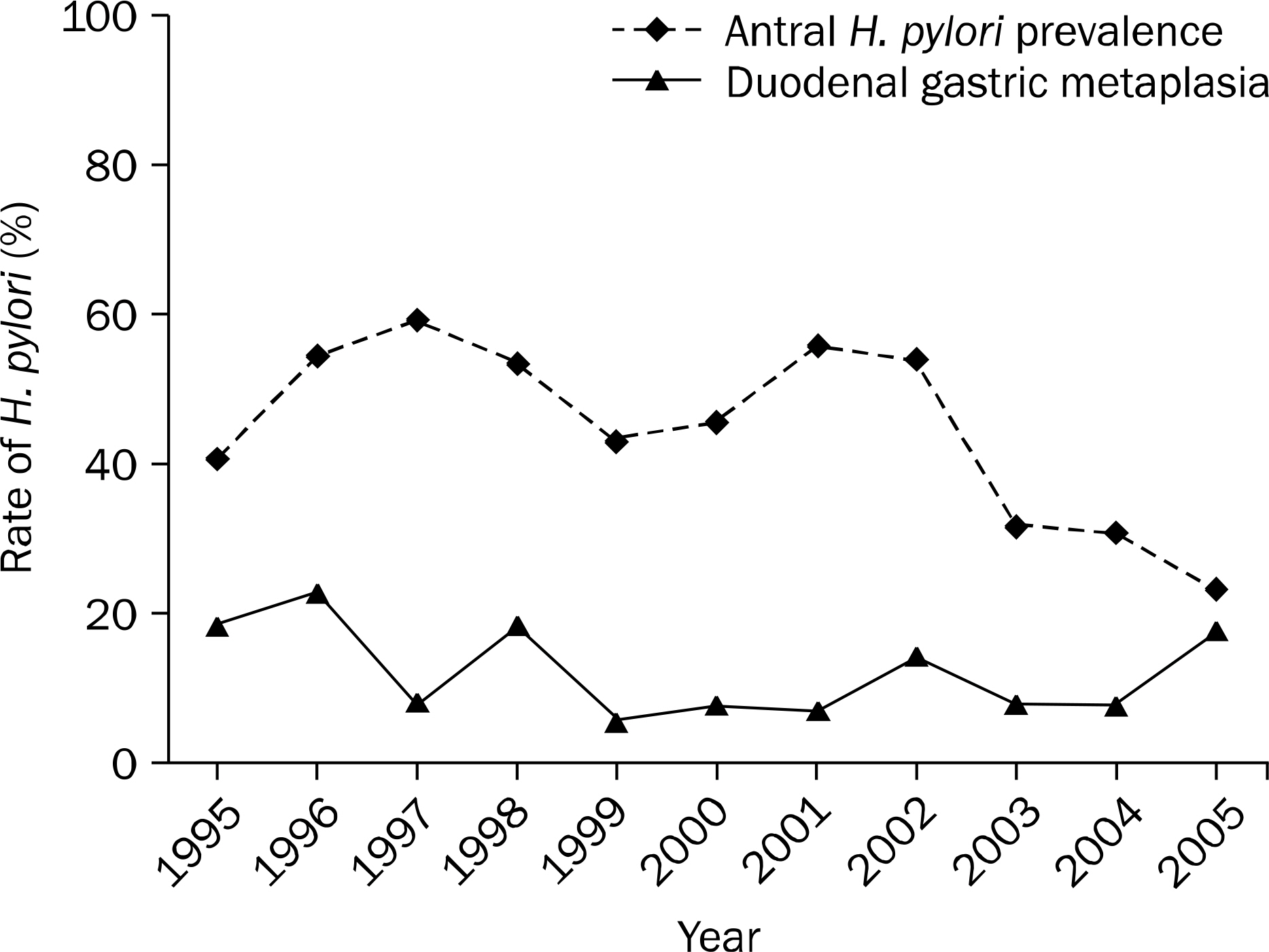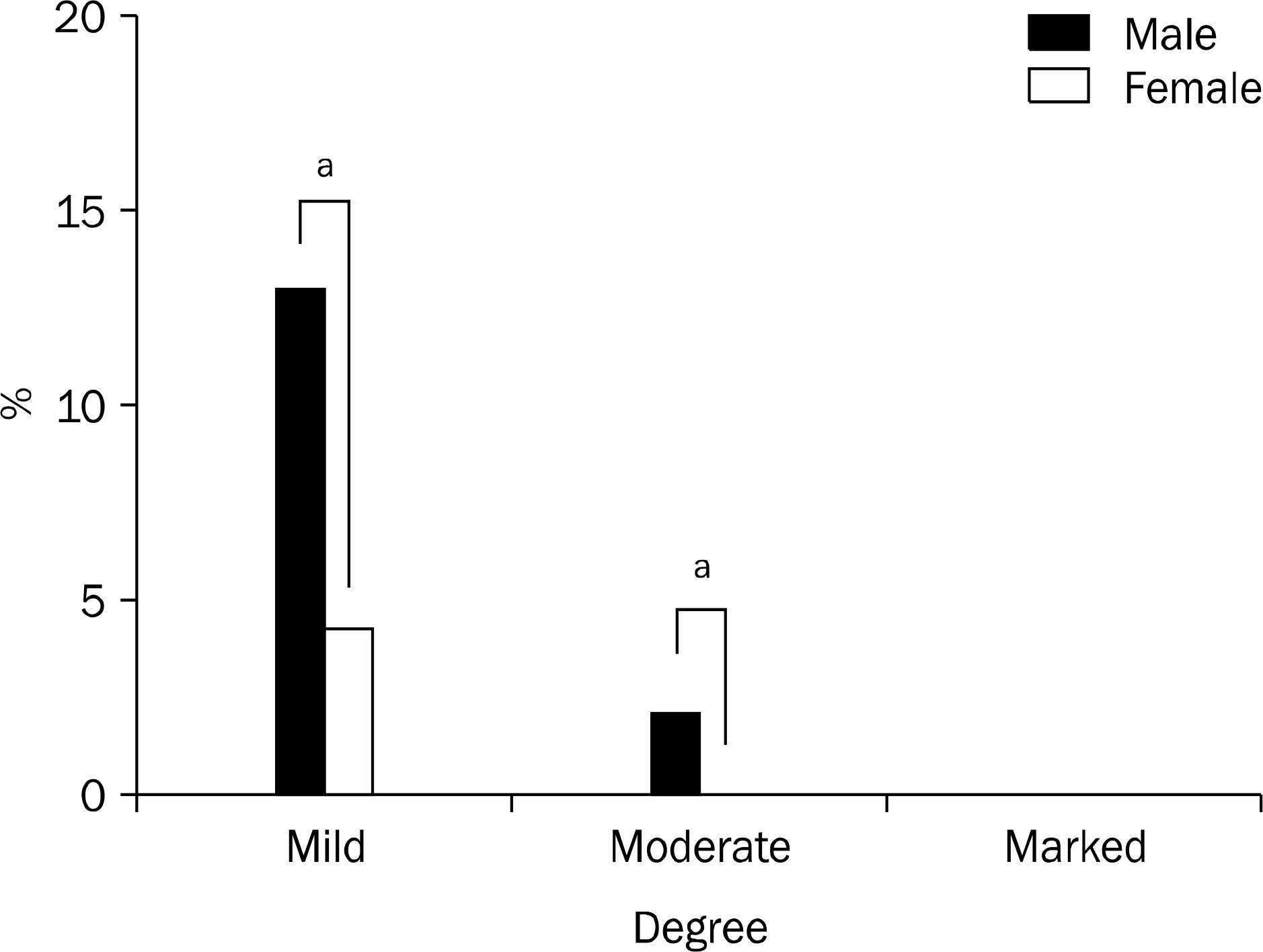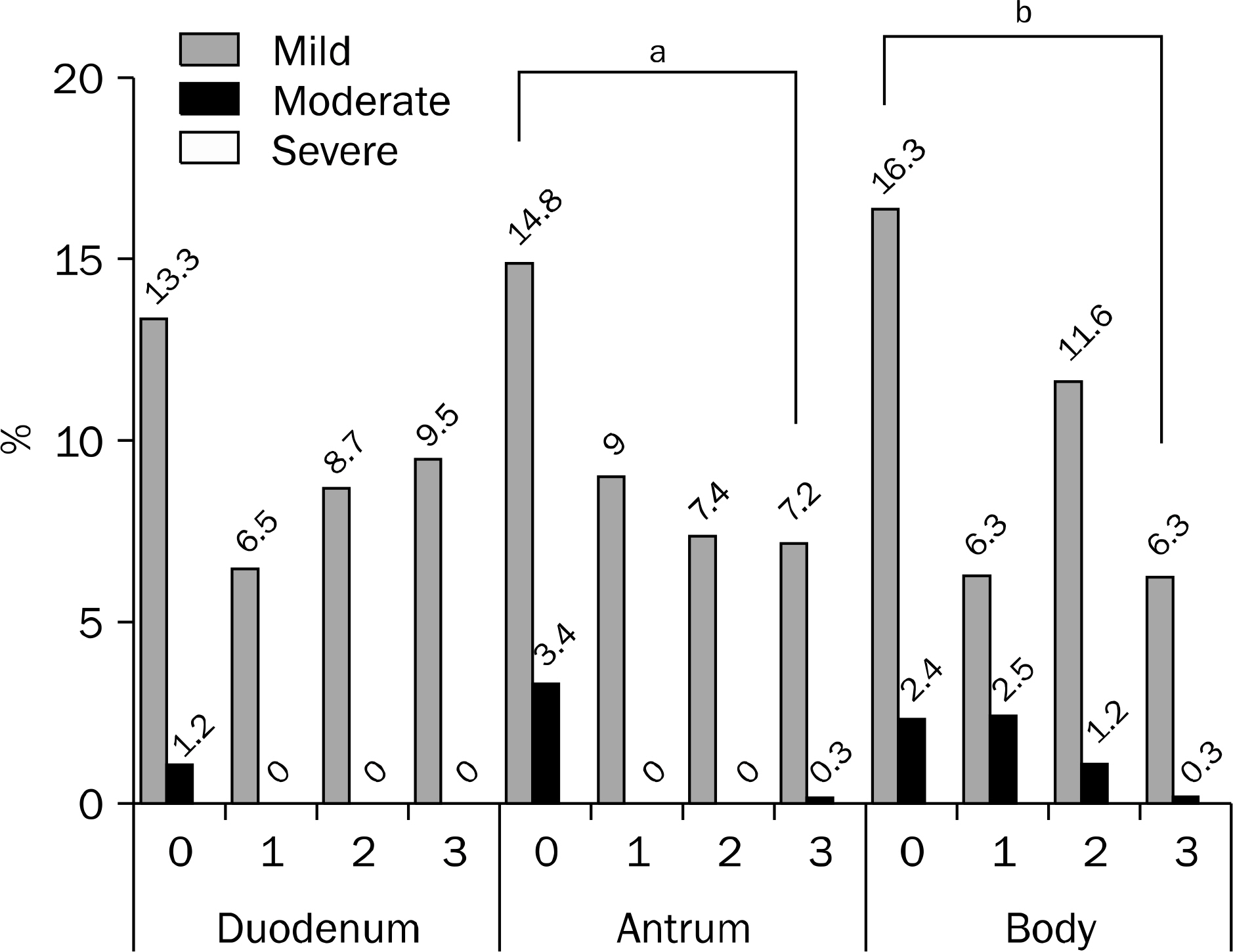Korean J Gastroenterol.
2013 Apr;61(4):191-195. 10.4166/kjg.2013.61.4.191.
Helicobacter pylori Infection and Duodenal Gastric Metaplasia in Healthy Young Adults
- Affiliations
-
- 1Department of Pediatrics, Gyeongsang National University School of Medicine, Gyeongsang Institute of Health Science, Jinju, Korea. hsyoun@gnu.ac.kr
- 2Department of Pathology, Gyeongsang National University School of Medicine, Gyeongsang Institute of Health Science, Jinju, Korea.
- 3Department of Microbiology, Gyeongsang National University School of Medicine, Gyeongsang Institute of Health Science, Jinju, Korea.
- KMID: 1775757
- DOI: http://doi.org/10.4166/kjg.2013.61.4.191
Abstract
- BACKGROUND/AIMS
Duodenal ulcers occur relatively frequently in adolescents, like in adults, and may relate to Helicobacter pylori infection and duodenal gastric metaplasia (DGM). This study investigated the association between H. pylori infection and DGM in healthy adults aged 20-29.
METHODS
Between 1995 and 2005, endoscopic biopsies of the duodenum, antrum and body were taken from healthy, young volunteers, who were first-year medical students, faculty staff, residents, and research assistants of Gyeongsang National University in Jinju, Korea. Urease tests were performed and the extent of DGM and histopathological grades according to the Updated Sydney System were determined.
RESULTS
In total, 662 subjects were enrolled (429 males and 233 females). The median age was 22.3 years. The overall incidence of DGM was 11.5% but DGM was more frequent in males (15.4%) than in females (4.3%) (p<0.0001). While H. pylori positivity rates changed significantly during the 1995-2005 period (p<0.01), the incidences of DGM did not. DGM was observed in 7.2% and 14.9% of subjects who were and were not colonized with H. pylori, respectively. DGM was also associated with less severe chronic gastritis and the absence of active gastritis in both the antrum and body, and the absence of follicles in the antrum (p<0.05).
CONCLUSIONS
These findings suggested that DGM is not rare in healthy young adults and is unrelated to gastric H. pylori infection.
Keyword
MeSH Terms
Figure
Reference
-
References
1. Warren JR, Marshall BJ. Unidentified curved bacilli on gastric epithelium in active chronic gastritis. Lancet. 1983; 1:1273–1275.2. Futami H, Takashima M, Furuta T, Hanai H, Kaneko E. Relationship between Helicobacter pylori infection and gastric metaplasia in the duodenal bulb in the pathogenesis of duodenal ulcer. J Gastroenterol Hepatol. 1999; 14:114–119.3. Egbaria R, Levine A, Tamir A, Shaoul R. Peptic ulcers and erosions are common in Israeli children undergoing upper endoscopy. Helicobacter. 2008; 13:62–68.
Article4. Rhee KH, Youn HS, Baik SC, et al. Prevalence of Helicobacter pylori infection in Korea. J Korean Soc Microbiol. 1990; 25:475–490.5. Graham DY. Campylobacter pylori and peptic ulcer disease. Gastroenterology. 1989; 96(2 Pt 2 Suppl):615–625.6. Lessells AM, Martin DF. Heterotopic gastric mucosa in the duodenum. J Clin Pathol. 1982; 35:591–595.
Article7. Kawaguchi M, Saito T. Incidence of gastric metaplasia and Helicobacter pylori Infection in duodenal bulb with specific reference to Patients with duodenal ulcers. Diagn Ther Endosc. 1999; 6:17–23.8. Dixon MF, Genta RM, Yardley JH, Correa P. Classification and grading of gastritis. The updated Sydney system. International workshop on the histopathology of gastritis, Houston 1994. Am J Surg Pathol. 1996; 20:1161–1181.9. Song DH, Kim DC, Lee JS, et al. Relationship of gastric metaplasia of the duodenum with age, duodenal ulcer and Helicobacter pylori Infection. Korean J Pathol. 2007; 41:217–223.10. Harris AW, Gummett PA, Walker MM, Misiewicz JJ, Baron JH. Relation between gastric acid output, Helicobacter pylori, and gastric metaplasia in the duodenal bulb. Gut. 1996; 39:513–520.11. Wyatt JI, Rathbone BJ, Sobala GM, et al. Gastric epithelium in the duodenum: its association with Helicobacter pylori and inflammation. J Clin Pathol. 1990; 43:981–986.12. Gormally SM, Kierce BM, Daly LE, et al. Gastric metaplasia and duodenal ulcer disease in children infected by Helicobacter pylori. Gut. 1996; 38:513–517.13. Fitzgibbons PL, Dooley CP, Cohen H, Appleman MD. Prevalence of gastric metaplasia, inflammation, and Campylobacter pylori in the duodenum of members of a normal population. Am J Clin Pathol. 1988; 90:711–714.14. Voutilainen M, Juhola M, Färkkilä M, Sipponen P. Gastric metaplasia and chronic inflammation at the duodenal bulb mucosa. Dig Liver Dis. 2003; 35:94–98.
Article15. Elitsur Y, Triest WE. Is duodenal gastric metaplasia a consequence of Helicobacter pylori infection in children? Am J Gastroenterol. 1997; 92:2216–2219.16. Gisbert JP, Blanco M, Cruzado AI, Pajares JM. Helicobacter pylori infection, gastric metaplasia in the duodenum and the relationship with ulcer recurrence. Eur J Gastroenterol Hepatol. 2000; 12:1295–1298.17. Olbe L, Fändriks L, Hamlet A, Svennerholm AM. Conceivable mechanisms by which Helicobacter pylori provokes duodenal ulcer disease. Baillieres Best Pract Res Clin Gastroenterol. 2000; 14:1–12.18. Khulusi S, Badve S, Patel P, et al. Pathogenesis of gastric metaplasia of the human duodenum: role of Helicobacter pylori, gastric acid, and ulceration. Gastroenterology. 1996; 110:452–458.19. Genta RM, Kinsey RS, Singhal A, Suterwala S. Gastric foveolar metaplasia and gastric heterotopia in the duodenum: no evidence of an etiologic role for Helicobacter pylori. Hum Pathol. 2010; 41:1593–1600.20. Savarino V, Mela GS, Zentilin P, et al. 24-hour gastric pH and extent of duodenal gastric metaplasia in Helicobacter pylori-positive patients. Gastroenterology. 1997; 113:741–745.21. Wyatt JI, Rathbone BJ. Gastric metaplasia in the duodenum and Campylobacter pylori. Gastroenterol Clin Biol. 1989; 13:78B–82B.22. Noach LA, Rolf TM, Bosma NB, et al. Gastric metaplasia and Helicobacter pylori infection. Gut. 1993; 34:1510–1514.23. Cai S, García Rodríguez LA, Massó-GonZález EL, et al. Uncomplicated peptic ulcer in the UK: trends from 1997 to 2005. Aliment Pharmacol Ther. 2009; 30:1039–1048.
Article
- Full Text Links
- Actions
-
Cited
- CITED
-
- Close
- Share
- Similar articles
-
- Clinicopathologic Features of the Duodenum Related to the Genesis of Duodenal Gastric Metaplasia
- Does Helicobacter pylori Not Relate to Duodenal Gastric Metaplasia in Healthy Young Adults?
- Relationship of Gastric Metaplasia of the Duodenum with Age, Duodenal Ulcer and Helicobacter pylori Infection
- A Case of Polypoid Gastric Metaplasia in Duodenal Bulb
- Gastric metaplasia and Helicobacter pylori infection of duodenal mucosa in duodenal ulcer




